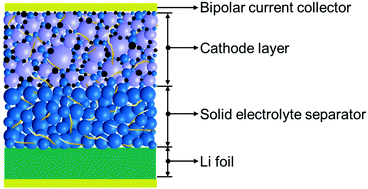Configuring solid-state batteries to power electric vehicles: a deliberation on technology, chemistry and energy†
Abstract
Solid-state batteries (SSBs) have been widely regarded as a promising electrochemical energy storage technology to power electric vehicles (EVs) that raise battery safety and energy/power densities as kernel metrics to achieve high-safety, long-range and fast-charge operations. Governments around the world have set ambitious yet imperative goals on battery energy density; however, sluggish charge transport and challenging processing routes of SSBs raise doubts of whether they have the possibility to meet such targets. In this contribution, the battery development roadmap of China is set as the guideline to direct how material chemistries and processing parameters of SSBs need to be optimized to fulfill the requirements of battery energy density. Starting with the identification of bipolar cell configurations in SSBs, the blade cell dimension is then selected as an emerging cell format to clarify weight breakdown of a solid NCM523||Li cell. Quantifying energy densities of SSBs by varying key cell parameters reveals the importance of active material content, cathode layer thickness and solid-electrolyte–separator thickness, whereas the thicknesses of the lithium metal anode and bipolar current collector have mild impacts. Even in the pushing conditions (200 μm for the cathode layer and 20 μm for the solid electrolyte separator), high-nickel ternary (NCM) cathodes hardly meet the expectation of the battery development roadmap in terms of gravimetric energy density at a cell level, while lithium- and manganese-rich ternary (LM-NCM) and sulfur cathodes are feasible. In particular, solid lithium–sulfur batteries, which exhibit exciting gravimetric energy density yet inferior volumetric energy density, need to be well-positioned to adapt diverse application scenarios. This analysis unambiguously defines promising battery chemistries and establishes how key parameters of SSBs can be tailored to cooperatively follow the stringent targets of future battery development.

- This article is part of the themed collections: ChemComm Milestones – First Independent Articles and Precious Elements


 Please wait while we load your content...
Please wait while we load your content...